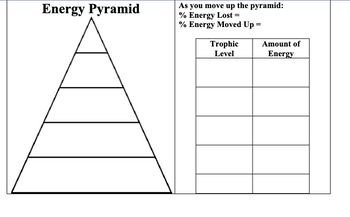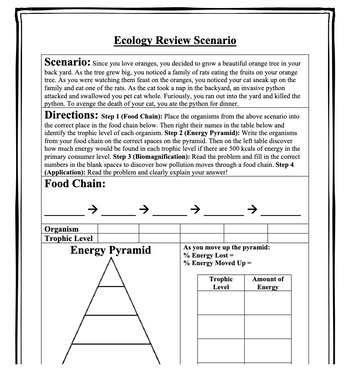
Concept explainers
All blanks need to be answered please:
Biomagnification: DDT is a pesticide used to kill insects on your orange tree.
This is poisonous to consume. Each orange contains 1 DDT particles. If the rat eats 5 oranges
it will have ______ DDT particles in its body. If the cat eats 10 rats, it will have ______ DDT
in its body. If the python eats 20 cats, it will have ______ DDT in its body. If you eat 4
pythons, you will have ______ DDT in your body.
Overall, as you move up a food chain the amount of pollution / poison in each trophic level
will _________________.
Application: Answer the following question based on your food chain above.
Suppose a deadly disease wiped out all of the pythons in the food chain. How would this affect
the population of the other 4 organisms? Why?
Answer =


Trending nowThis is a popular solution!
Step by stepSolved in 4 steps with 1 images

- I need a customer survey information for my app Note: we made an app where farmers can directly sell their products (crops) to the people without any mediators (humans).arrow_forwardCan I get an introduction or background information about synthesis and spectrophotometric of aspirin please thank youarrow_forwardB D LLUI — F H J K L ΣΤΟ M- N P dc ve and submit. Click Save All Answers to save all answers. 1 Save All Answarrow_forward
- 12:04 PM Fri Jun 11 9 100% The_Farmer_and_the_Fly Home Insert Draw Layout Review View Times New Roma I U A.. A READ ONLY - This is an older file format. To make changes, make a copy of the file in the new format. Upgrade a copy THE FARMER AND THE FLY: PART II Using the information from your explanation in Part I, the agricultural research facility has set up a new program for controlling the fly population in the chicken houses. The facility has purchased two additional insecticides, Formula B and C. These insecticides are equally strong as Formula A, but have different chemical formulas. The facility has set up the following program for using the three insecticides. Program: Year one: Use Formula A only Year two: Use Formula B only (no A or C) Year three: Use Formula C only (no B or A) Use your knowledge of variation, evolution and natural selection to answer the following questions. 1. At the end of year one, to which insecticide will the living flies be resistant? Explain your…arrow_forwardDocument1 - Word Kosi Okogwu File Home Insert Design Layout References Mailings Review View Help Tell me what you want to do 유 Share % Cut A A := - E - O Find - Aa v AaBbCcC AaBbCcC AaBb AaBbC AaBbCcD AaB AaBbCcD AaBbCcDd AaBbCcDd Calibri -|12 Ee Copy abc Replace Paste U v abe X, X aly v A v 1 Normal 1 No Spac... Heading 1 Heading 2 Heading 3 Title Subtitle Subtle Em. Emphasis V Format Painter A Select v Clipboard Font Paragraph Styles Editing 2) The image in Figure 2 is of the diatom, Fragilariopsis cylindrus. Determine the size (length) of the diatom indicated by the red arrow and determine the magnification used. Show your calculations. 5.0 um Figure 2: Scanning electron micrograph of Fragilariopsis cylindrus cells. Page 2 of 8 1505 words KAccessibility: Investigate 110%arrow_forwardCan you identify codes in the Medicine section (90,000 CODES) that could be located in the Evaluation and Management, Surgery, Radiology, or Pathology sections? If so, please describe them.arrow_forward
 Human Anatomy & Physiology (11th Edition)BiologyISBN:9780134580999Author:Elaine N. Marieb, Katja N. HoehnPublisher:PEARSON
Human Anatomy & Physiology (11th Edition)BiologyISBN:9780134580999Author:Elaine N. Marieb, Katja N. HoehnPublisher:PEARSON Biology 2eBiologyISBN:9781947172517Author:Matthew Douglas, Jung Choi, Mary Ann ClarkPublisher:OpenStax
Biology 2eBiologyISBN:9781947172517Author:Matthew Douglas, Jung Choi, Mary Ann ClarkPublisher:OpenStax Anatomy & PhysiologyBiologyISBN:9781259398629Author:McKinley, Michael P., O'loughlin, Valerie Dean, Bidle, Theresa StouterPublisher:Mcgraw Hill Education,
Anatomy & PhysiologyBiologyISBN:9781259398629Author:McKinley, Michael P., O'loughlin, Valerie Dean, Bidle, Theresa StouterPublisher:Mcgraw Hill Education, Molecular Biology of the Cell (Sixth Edition)BiologyISBN:9780815344322Author:Bruce Alberts, Alexander D. Johnson, Julian Lewis, David Morgan, Martin Raff, Keith Roberts, Peter WalterPublisher:W. W. Norton & Company
Molecular Biology of the Cell (Sixth Edition)BiologyISBN:9780815344322Author:Bruce Alberts, Alexander D. Johnson, Julian Lewis, David Morgan, Martin Raff, Keith Roberts, Peter WalterPublisher:W. W. Norton & Company Laboratory Manual For Human Anatomy & PhysiologyBiologyISBN:9781260159363Author:Martin, Terry R., Prentice-craver, CynthiaPublisher:McGraw-Hill Publishing Co.
Laboratory Manual For Human Anatomy & PhysiologyBiologyISBN:9781260159363Author:Martin, Terry R., Prentice-craver, CynthiaPublisher:McGraw-Hill Publishing Co. Inquiry Into Life (16th Edition)BiologyISBN:9781260231700Author:Sylvia S. Mader, Michael WindelspechtPublisher:McGraw Hill Education
Inquiry Into Life (16th Edition)BiologyISBN:9781260231700Author:Sylvia S. Mader, Michael WindelspechtPublisher:McGraw Hill Education





